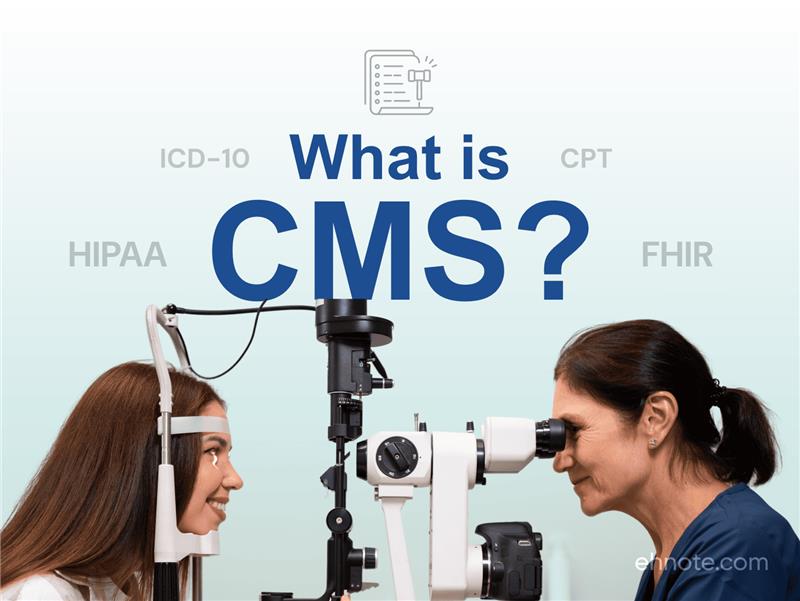Why Ophthalmology Practices Can’t Ignore CMS’s Health-IT Agenda

Key Takeaway:
- CMS sets the rules for healthcare reimbursement, compliance, and EHR certification.
- Ophthalmology practices must use certified, interoperable systems to meet CMS standards.
- EHNOTE helps practices stay compliant, reduce documentation time, improve reimbursements, and achieve ROI.
The Centers for Medicare & Medicaid Services (CMS) is the U.S. federal agency that oversees Medicare, Medicaid, CHIP and other major health-coverage programs. Beyond payment policy, CMS is a driving force behind health-IT advancement—especially electronic health records (EHRs), interoperability standards, and value-based care. TechTarget
For ophthalmology practices, this means two things:
- Your EHR and clinical systems must meet regulatory and interoperability expectations.
- The business model for eye care is shifting—aligning to value, quality, and efficient workflows.
What Is CMS and Why Does It Matter in Healthcare IT?
CMS is the U.S. federal agency that oversees Medicare, Medicaid, CHIP, and other national health programs.
It sets regulations, payment models, and technology standards that healthcare providers must follow.
For ophthalmology practices, CMS directly affects how clinical documentation, billing, and reporting are handled through certified EHR systems.
CMS, in collaboration with the Office of the National Coordinator (ONC), also certifies EHR software to ensure data security, interoperability, and compliance with healthcare standards like HIPAA, ICD-10, CPT, and FHIR.
How Does CMS Influence Ophthalmology Practices?
CMS encourages all medical specialties—including ophthalmology—to adopt technology that improves patient outcomes and operational efficiency. Here’s how it affects eye-care providers specifically:
- EHR Certification Requirements: Only ONC-certified systems qualify for CMS incentive programs and avoid penalties.
- Value-Based Reimbursement: Under programs like MIPS, reimbursement is tied to quality, cost, and patient outcomes.
- Interoperability Expectations: Practices must be able to exchange data seamlessly with labs, imaging centers, and other providers.
- Documentation & Coding Accuracy: CMS audits rely on clean, accurate coding (ICD, CPT, SNOMED) for proper claims and reporting.
- Patient-Centric Care Standards: CMS emphasizes engagement tools like portals, digital check-ins, and telehealth.
In short: CMS compliance isn’t optional—it’s essential for both financial health and clinical excellence.
How Can Ophthalmology Practices Stay Compliant with CMS Guidelines?
To align with CMS, practices should focus on certified software, automation, and complete data visibility. Here’s a step-by-step approach:
- Use an ONC-Certified EHR - Ensures you meet interoperability, security, and documentation standards.
- Automate Charting and Coding - Reduces human error and maintains audit-ready documentation.
- Track MIPS Performance - Monitor scoring and compliance prompts directly within your EHR.
- Ensure Clean Data Migration - Avoid loss of historical records when upgrading systems.
- Adopt Digital Patient Tools - Patient portals, self-check-in, and reminders enhance engagement and outcomes.
What Makes EHNOTE the Right Platform for CMS Compliance?
EHNOTE is built specifically for ophthalmology and ASC workflows, not as a generic EHR retrofit.
It’s designed to help practices meet CMS expectations easily—while boosting efficiency and ROI.
Here’s how:
- ONC-Certified EHR — that meets CMS and ONC interoperability requirements.
- Automated Documentation & Coding — 98% accuracy, fewer denials, better reimbursements.
- 90% Charts Completed at Time of Visit — eliminates backlogs and compliance risks.
- MIPS & MACRA Alerts Built-In — stay aligned with CMS reporting and avoid penalties.
- Seamless EHR + ASC Integration — automatic data flow from clinic to surgery center.
- Data Migration & Zero-Downtime Implementation — CMS-ready transition without losing data.
- Cloud-Native, HIPAA-Compliant Infrastructure — secure, scalable, and future-proof.
With EHNOTE, ophthalmology practices can save 180+ hours per provider annually, improve surgery conversions by 25%, and see ROI in just four months—all while staying fully CMS-compliant.
How Is CMS Shaping the Future of Ophthalmology Technology?
CMS continues to push the healthcare industry toward:
- Interoperability and Open Data Exchange (HL7 FHIR standards).
- Outcome-Based Reimbursements rather than fee-for-service models.
- AI-Supported Documentation & Coding to improve accuracy and reduce burden.
- Integrated, Cloud-Based Platforms that unify EHR, ASC, PMS, and billing in one place.
Practices that adopt a single, ophthalmology-focused platform like EHNOTE stay ahead of these changes—reducing fragmentation, improving quality metrics, and ensuring smooth audits.
What’s the Best Way Forward?
CMS isn’t just a regulatory body—it’s the roadmap for modern, efficient, and accountable eye care.
By using an all-in-one, ophthalmology-native platform like EHNOTE, practices can remain compliant, improve patient outcomes, and achieve sustainable growth in the value-based era.
Ready to see how better data can drive both better care and better revenue?
Learn More About EHNOTE’s Ophthalmology EHR Software